

Cases and Chambers |
Some parts of an organ are usually visible in the room in which the instrument is installed, while others are almost never seen. The most distinctive visual feature of an organ is the pipes themselves, and they may be displayed in different ways, or they may be enclosed in one fashion or another. In general a division of pipes may be
 An organ case is a free-standing
structure that is essentially a wooden box open to the front. A chest is
positioned at the bottom of a case,
and the pipes above it are
free to speak through the opening in the front. A separate case may be provided for
each division
of an instrument, or several divisions may be placed in one case. The diagram to the
right shows
the essential parts of a case that contains one division. The pipes of one rank are
represented
graphically by red rectangles, and the interior surfaces of the case are shown in
blue.
An organ case is a free-standing
structure that is essentially a wooden box open to the front. A chest is
positioned at the bottom of a case,
and the pipes above it are
free to speak through the opening in the front. A separate case may be provided for
each division
of an instrument, or several divisions may be placed in one case. The diagram to the
right shows
the essential parts of a case that contains one division. The pipes of one rank are
represented
graphically by red rectangles, and the interior surfaces of the case are shown in
blue.
Pipes are usually placed in a case with the taller pipes in front with progressively
smaller pipes
behind the front or façade pipes. Two exceptions are common:
Cases serve two primary functions:
 Historically, cases have been
treated as almost sculptural objects, and their design can be a distinguishing
feature of several
types of organ built in different centuries. The organ in the photograph to the right
has a case
modeled on a sixteenth century Dutch organ. It is fitted with folding panels which
can be used to
close the front of the case.71
Historically, cases have been
treated as almost sculptural objects, and their design can be a distinguishing
feature of several
types of organ built in different centuries. The organ in the photograph to the right
has a case
modeled on a sixteenth century Dutch organ. It is fitted with folding panels which
can be used to
close the front of the case.71
In the later years of the nineteenth century, builders began placing organs in chambers, often a separate room open to the space in which the instrument was meant to be heard. This practice continues, although the movement since 1950 has been to avoid chambers when possible so that the sound is not trapped by architectural elements that define the chamber itself.
 Chambers can be covered with
grills that completely hide the pipes behind them. The photograph to the left does
not show any
pipes. The chest and pipes are behind the arched grill, which forms the wall behind
the choir
loft.
72
Chambers can be covered with
grills that completely hide the pipes behind them. The photograph to the left does
not show any
pipes. The chest and pipes are behind the arched grill, which forms the wall behind
the choir
loft.
72
 In other installations, a
façade that is modeled on the front of a case can allow some pipes to be seen,
even though
most of them are located behind a wall in a chamber.
73
In other installations, a
façade that is modeled on the front of a case can allow some pipes to be seen,
even though
most of them are located behind a wall in a chamber.
73
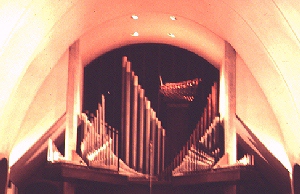 A pipe sounds at only one
dynamic level when it is played. If more wind is supplied the pipe in order to
increase its dynamic
level, the both its pitch and its timbre are affected. In order to provide some
method of changing
the dynamic level of pipes, a case or a chamber may be fitted with a set of louvered
shades that
form a fourth wall, the opening through which sound emerges to the listener. Exposed
pipes, or
those that are in cases or chambers that do not have these devices, sound at only one
dynamic
level. The photograph to the right shows an installation in which the pipes of the
Great, Positiv
and Pedal divisions are exposed.
68
A pipe sounds at only one
dynamic level when it is played. If more wind is supplied the pipe in order to
increase its dynamic
level, the both its pitch and its timbre are affected. In order to provide some
method of changing
the dynamic level of pipes, a case or a chamber may be fitted with a set of louvered
shades that
form a fourth wall, the opening through which sound emerges to the listener. Exposed
pipes, or
those that are in cases or chambers that do not have these devices, sound at only one
dynamic
level. The photograph to the right shows an installation in which the pipes of the
Great, Positiv
and Pedal divisions are exposed.
68
The fourth division of the organ above is a Swell division, located in a
chamber behind the
exposed pipes. As in all such divisions, the front of the chamber - - the side that
is open to the
room in which the organ is to be heard - - is fitted with swell shades or
swell
shutters, which allow the organist to open or close the opening from the console.
In this
example, the shutters themselves are covered with a grill, so that they cannot be
seen; in other
installations, they are visible, and their movement can be seen by the listener.
 Swell shutters may be placed in
either a horizontal or a vertical position. Regardless of their
direction, they work in essentially the same way. The diagram to the left represents
the view from
above of a small enclosure, outlined in blue, that contains twelve pipes, represented
by the black
circles. The red shapes represent the swell shutters. When they are closed, they
form a fourth
wall, but when they are open, the fourth wall is open to allow the sound of the pipes
to exit the
enclosure.
Swell shutters may be placed in
either a horizontal or a vertical position. Regardless of their
direction, they work in essentially the same way. The diagram to the left represents
the view from
above of a small enclosure, outlined in blue, that contains twelve pipes, represented
by the black
circles. The red shapes represent the swell shutters. When they are closed, they
form a fourth
wall, but when they are open, the fourth wall is open to allow the sound of the pipes
to exit the
enclosure.
The action that controls the movement of swell shutters can be one of several types:
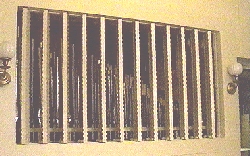 Although many installations do not allow the swell shades to be
seen, some organs use the shades
as an effective part of their facades. The photograph to the left shows a set of
swell shutters in a home installation,
where the shutters themselves form one wall of a room.
103
The way shades are seen as they open is demonstrated in the three photographs below.
They show a small instrument
with an enclosed division immediately above the keydesk.
104
Although many installations do not allow the swell shades to be
seen, some organs use the shades
as an effective part of their facades. The photograph to the left shows a set of
swell shutters in a home installation,
where the shutters themselves form one wall of a room.
103
The way shades are seen as they open is demonstrated in the three photographs below.
They show a small instrument
with an enclosed division immediately above the keydesk.
104
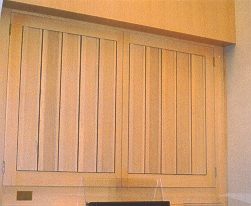
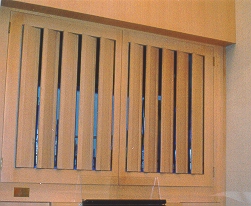
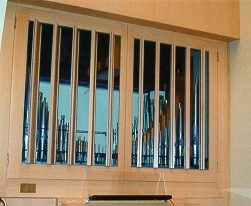
A short film of a set of shades in motion is available.
- The file is in AVI format (Cinepak Codec) and is about 2.5 MB in size.
- Some browsers will show a set of controls to begin the film. Others will require a click on the image to start the film.
- A chord is sustained at the beginning of the film, with the shades in the closed position. The shades are first opened, then closed, while the chord is being sustained.
- With some browsers, it will be necessary to use the "back" button to return to this page after viewing the film.
© 1998 James H. Cook